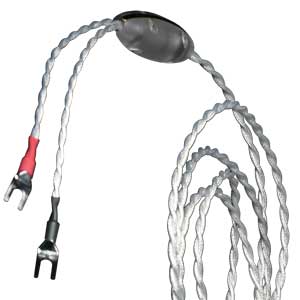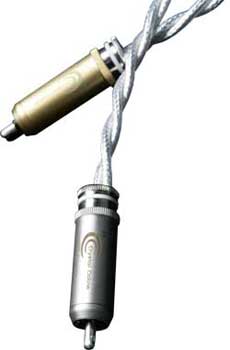| Dream a little - Crystal
Cable Dreamline Speaker Cables & Interconnects |
Crystal Cable Delivers Clarity
and Performance with their Dreamline Speaker Cables and Interconnects
In The Inner Ear’s last print issue (Vol 17 No. 4/2007), I
had the opportunity to review Crystal Cables’ earlier high-end
speaker cable — the Ultra.
I remember it well, because its performance was extraordinary. The Ultras’ performance
highlights included speed, transparency, resolution and a high degree of sonic
neutrality. And just when I thought that these cables couldn’t be improved,
Gaby van der Kley, Crystal’s president and founder, shocked the electronics
industry (and me) with a new no-holds-barred design for the discriminating listener.
Benjamin Scarcelli, Canadian distributor for Crystal products, provided a
two-meter pair of the new Dreamline speaker cable and the matching interconnects
and I began to evaluate their performance in a variety of amp/speaker systems,
I had in-house at the time. Before I get to the nitty gritty, however, I’d
like comment on the Dreamline’s presentation — the containers for
both cables. No doubt, packaging Crystal Cable’s top of the line product
is a display of the cable’s rank and its lineage. Packed in a handbag-like
black suede case, it would not surprise me to see it worn on the street. The
material is pleasant to the touch as it elicits an almost sinful, perverse
response. Both, the interconnects and the speaker cables are packed in these “handbags” which
remind of designs from Gucci, Fendi etc.
|
 Although simple in configuration these
speaker cables
Although simple in configuration these
speaker cables
offer maximum signal transimission. |
The Speaker Cables
Well! I heard great things right out of the box, even before the cables were
burnt in. A week later, the Dreamline’s definitive sonic disposition unfolded
and I started my auditioning sessions. The systems used were Art Audio’s
Symphony II single-ended amp, Wyetech Labs Opal preamp, a pair of WLM Diva monitors
and an Audio Aero Capitol SE CD player as the source component. For another system,
I used the Simaudio Moon components — W-8 amp, P-8 preamp, and Andromeda
CD player with the same speakers. These two systems are state of the art in their
price categories and both systems allowed a clear perspective into the Dreamline
cables’ sonic make up. Here is what you can expect with a good system combination:
Count on one of the most spatial sound stages you have ever heard; anticipate
and enjoy the smoothest high frequencies from you loudspeakers. Violins, horns
and woodwinds, cymbals and other instruments performing in the high frequency
domain will sound very organic and give you the feeling of a being there at alive
performance. However, the smoothness does not overwhelm the cables’ ability
to properly deal with resolution in the high, mid and low frequency ranges. That,
dear reader, is not easily achieved as most musical information takes place in
high and mid frequencies and too much smoothness often obscures the finishing
resolution. I found that the cable’s ability to handle music’s fundamental
tones is one of its exceptional accomplishments, but in addition, pitch, harmony,
volume, rhythm and timbre are rendered simultaneously. This is rarely talked
about, but in a well-assembled sound system all aforementioned elements must
be present if we want to hear the complete and extremely complex harmonious possibilities
of reproduced music.

Interconnects sporting NextGen RCA’s made by WBT. |
The
Dreamline — both
speaker cables and interconnects — sounded
impressive straight out of the box, but when properly burned
in, I thought that the most conspicuous element is the cable’s
ability to recreate an unobstructed multi-dimensional sound stage.
That is to say that front-to-back, horizontal and vertical dimensions
are appropriately presented, but in addition to these important
elements, the often-ignored dimension of space/time further magnifies
the sensation of listening to an integral musical landscape.
The Interconnects
I tested the interconnects with my source components — a Magnum Dynalab
tuner and the CD players mentioned above, and quickly established that the
cable didn’t imprint its personality, thereby allowing a clear perspective
of the source components. This brings me to the cables’ voice or personality;
and that is difficult to explain. In the world of reviewers, we can only guess
at the sound of neutrality, actually an oxymoron, since neutral can be defined
as colourless, impartial, even boring. But in the cable industry, neutrality
is a good thing, because it allows the end-user to choose what they like in
amps, preamps and source components. A lot of high-end cables offer a high
degree of sonic impartiality, although this cannot be scientifically confirmed
and readers will have to take a reviewer’s word for it. Be this as it
may, I hold that all cables have a personality, but even if they were entirely
impartial, they are going to interact with components. If, as I believe, the
Dreamline is a very neutral conductor it acts like a large spout would in an
aquatic environment. Nothing seems hidden; nothing seems out of whack; and
that, folks, spells high performance made for those of us who are spoiled.
|
Synopsis & Commentary
In the world of high-end audio, cables should be considered another component,
but they should disappear — sonically speaking — just like you’d
expect from a superb pair of loudspeakers. I see these cables (speaker and interconnects)
as the tools that intensifies the listening experience and magnifies the musical
performance — that’s as good as it gets for it points at a cable
that has it all: technology applied where it makes a difference, a high degree
of musicality and a price/performance ratio, I believe is appropriate. These
are wonderful cables — congrats Gaby.
| MODELS |
|
MANUFACTURER |
| Dreamline Speaker Cables and interconnects |
Crystal Cable |
| RATING |
CONTACT |
Speaker Cables
♪♪♪♪
interconnects
♪♪♪♪ |
Audio Basics, Inc.
877.92AUDIO
905.303.9232
CrystalCable.com
+31 26 353 9045 |
| PRICE |
|
Cdn. $15,500 (2 meter / pair speaker
cables)
Cdn. $7,300 (1 meter / pair RCA interconnects)
|
|
|
 |
TECHNOLOGY
Most, if not all, manufacturers strive
to come up with improvements in cable construction. All will adhere
to design parameters well established over the years addressing
well-known technical design elements which include controlling
a cable’s geometry and materials, not to speak of electrical
conditions such as resistance, inductance, impedance, etc. All
these elements have been taken into consideration when the Dreamline
cables were engineered, but there are a few interesting innovations
that may be responsible for the cable’s musical finesse.
The conductor material is a blend of gold and silver. Gold makes
for a great, never-deteriorating, contact and is the choice of
many manufacturers in the industry. Gold has a drawback inasmuch
as it isn’t the best conductor. Enter, a German/Swiss laboratory
that actually achieved a silver/gold metallurgy composition that
works very well indeed, though the methodology is very expensive.
The gold/silver conductors are used exclusively in the manufacture
of the Crystal cables high-end products.
Protecting the coaxial arrangement of the conductors is not only important for
insulating, but also to protect the cables from RFI and EMI contamination, widespread
in every household and workplace, thanks to radio, computers and other digital
elements. The Dreamline cables employ — and I quote —“space-age” dielectrics
such as Kapton, PEEK and Teflon — all coated around the conductor core.
This shielding is said to provide the most resistance to external interference.
Termination is another critical matter and Crystal Cable employs some of the
best currently available. The speaker cable I had in-house came with gold-plated
lugs, though I’m told that banana termination is also available.
The Interconnects sported NextGen RCA’s made by WBT. These plugs impressed
me, for I can see (and hear) that resistance has been greatly reduced by using
some hard plastic material on the ground contact. XLR and Neutrik connectors
can be ordered as well. Both cables come with, what the company calls, shaped
acrylic barrels to protect the termination link. I could not find indicators
for the cables’ direction and assume that directivity isn’t important.
However, when I burned in these cables, I used the “barrels” to slide
over to the amp side and thereby established a direction to follow in future
connections.
All the science in the world doesn’t guarantee musical success, but I established
that the Dreamline designers have succeeded marrying technology with musicology
or, to put it in another way, science with sensibility. This brings me to the
various auditions. |
|



